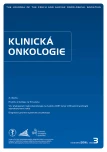Localized Amyloidosis Involving the Nasal Cavity
Authors:
R. Koukalová 1; P. Szturz 2; I. Svobodová 3; J. Stulík 4; Z. Řehák 1
Authors‘ workplace:
Oddělení nukleární medicíny, Masarykův onkologický ústav, Brno
1; Interní hematologická a onkologická klinika LF MU a FN Brno
2; I. patologicko-anatomický ústav, LF MU a FN u sv. Anny v Brně
3; Radiologická klinika LF MU a FN Brno
4
Published in:
Klin Onkol 2016; 29(3): 216-219
Category:
Case Reports
doi:
https://doi.org/10.14735/amko2016216
Overview
Background:
Amyloidosis is a disease characterized by deposits of abnormal protein known as amyloid in various organs and tissues. It can be classified into systemic or localized forms, the latter of which is less frequent. Deposition of amyloidogenic monoclonal light chains leads to the most common type of this disease called light-chain (AL) amyloidosis. 18F-FDG positron emission tomography/ computed tomography hybrid imaging (FDG-PET/ CT) demonstrates tracer uptake usually in all patients with localized amyloidosis as opposed to the systemic form.
Case:
Herein, we present a case of an otherwise healthy 56-year-old women diagnosed with a nasal polyp on the right side. The biopsy results were consistent with amyloidosis. FDG-PET/ CT imaging revealed a pathological, metabolically active lesion measuring 11 × 9 mm with a maximum standardized uptake value (SUVmax) of 3.47. No other distant pathological changes were identified. After a radical resection, the patient has been regularly followed-up with clinical and imaging methods (MRI, FDG-PET/ CT), both of which repeatedly showed normal findings with disease-free survival of 27 months. Thus, FDG-PET/ CT imaging plays an important role not only for obtaining the right diagnosis but also in the follow-up of patients after surgical resection. In accordance with the literature, this case report confirms that FDG-PET/ CT imaging holds promise as an auxiliary method for distinguishing between localized and systemic forms of amyloidosis.
Key words:
nasal polyp – amyloidosis – localized amyloidosis – positron-emission tomography – PET/CT
This work was supported in part by MZ ČR – RVO (MOÚ, 00209805), MŠMT – NPU I-LO1413, MZ ČR – RVO (FNBr, 65269705), 23/14/NAP, and MZ VES 16-31156A.
The authors declare they have no potential conflicts of interest concerning drugs, products, or services used in the study.
The Editorial Board declares that the manuscript met the ICMJE recommendation for biomedical papers.
Submitted:
19. 1. 2016
Accepted:
26. 1. 2016
Sources
1. Adam Z, Elleder M, Moulis M et al. Přínos PET-CT vyšetření pro rozhodování o léčbě lokalizované nodulární formy plicní AL-amyloidózy. Vnitř Lék 2012; 58(3): 241 – 252.
2. Rauba D, Lesinskas E, Petrulionis M. Isolated nasal amyloidosis: a case report. Medicina (Kaunas) 2013; 49(11): 497 – 503.
3. Eid M, Sturz P, Čermáková Z et al. Makroglosie jako příznak onemocnění kostní dřeně. Klin Onkol 2014; 27(3): 221 – 222. doi: 10.14735/ amko2014221.
4. Bancroft JD, Gamble M. Theory and practice of histological techniques. 5th ed. Edinburgh: Churchill Livingstone 2002.
5. Biewend ML, Menke DM, Calamia KT. The spectrum of localized amyloidosis: a case series of 20 patients and review of the literature. Amyloid 2006; 13(3): 135 – 142.
6. Glaudemans A, Slart R, Noordzij W et al. Utility of 18-F-FDG PET(/ CT) in patients with systemic and localized amyloidosis. Eur J Nucl Med Mol Imaging 2013; 40(7): 1095 – 1101.
7. Westermark P. Lokalized AL amyloidosis: a suicidal neoplasm? Ups J Med Sci 2012; 117(2): 224 – 250. doi: 10.3109/ 03009734.2012.654861.
Labels
Paediatric clinical oncology Surgery Clinical oncologyArticle was published in
Clinical Oncology

2016 Issue 3
- Metamizole vs. Tramadol in Postoperative Analgesia
- Metamizole at a Glance and in Practice – Effective Non-Opioid Analgesic for All Ages
- Possibilities of Using Metamizole in the Treatment of Acute Primary Headaches
- Metamizole in perioperative treatment in children under 14 years – results of a questionnaire survey from practice
- Obstacle Called Vasospasm: Which Solution Is Most Effective in Microsurgery and How to Pharmacologically Assist It?
Most read in this issue
- History of Oncology in Slovakia
- Lynch Syndrome – the Pathologist’s Diagnosis
- Evaluation of Dietary Habits in the Study of Pancreatic Cancer
- Localized Amyloidosis Involving the Nasal Cavity
